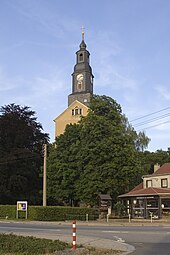Brand-Erbisdorf town church
The Protestant town church Brand-Erbisdorf is a Gothic, several times rebuilt hall church in Brand-Erbisdorf in the Saxon district of Central Saxony . It is known for its valuable late baroque organ made by Silbermann's student Adam Gottfried Oehme and belongs to the Evangelical Lutheran parish of Brand-Erbisdorf in the Freiberg church district of the Evangelical Lutheran Regional Church of Saxony .
History and architecture
The town church Brand-Erbisdorf was built around 1300 as a hall church in the early Gothic style. The west tower was built in 1598 by Melchior Gerber. After a fire in 1624 and several renovations, the church was given the shape of a large gallery hall. The exterior design of the hall and the tower took place in 1836, the choir was rebuilt in 1930. Restoration measures were carried out in the years 1870 and 1892 (inside), 1968 (inside), 1979/1980 (tower renovation), 1988–1993 (outside) and 1993/1994 (inside).
The church is a plastered building with a three-sided end, which is provided with buttresses. A round arched main portal made of sandstone in the west opens up the building. Different window shapes suggest an extensive building history. The interior has a flat ceiling and is equipped with wooden galleries on three sides. The choir room with the choir niche that just closed was built into the Gothic choir in such a way that the outer walls did not have to be changed. The Gothic windows cannot be seen inside. There are figural wall paintings on the south wall of the hall, the lower one presumably from the Gothic period. The door to the sacristy on the south side has a color succinct, round-arched guise of sandstone.
The four bells were destroyed by fire in 1835, and the new bells were melted down to war material during World War I in 1917 . After the war, steel bells were made in 1921 , which still ring at the beginning of the 21st century.
Furnishing
On the modern altar are a small altar cross marked 1774 and a large one from 1930. The earlier pulpit altar from 1603 by Franz Ditterich the Elder was dismantled, the four colored evangelists are integrated into the modern pulpit. Further relief scenes from the altar are kept in the sacristy, including a predella depicting the Last Supper, two side wings with the Annunciation , the birth of Christ and two seated figures depicting Moses and John Evangelista . The extract from the altar is attached to the left of the choir, above the gallery entrance. The simple baptismal font dates from 1929, a pewter baptismal font from 1516 with elaborate engraving of Eve's creation in the basin hollow came here from the church in the St. Michaelis district . Another baptism in cast iron was created in 1880. A life-size sandstone figure of a miner with a sensitive design of the surface structures, probably earlier a pulpit-carrying figure, was made by the Freiberg sculptor Samuel Lorentz around 1585. Wooden epitaphs and portraits of pastors from the 17th / 18th centuries Century complete the equipment. In the tower hall there is an ornamented keystone from the former church portal from 1580. On the south wall of the entrance hall is a carved epitaph for Georg Hermann and his wife Christina from around 1686. It shows a round picture of the two people in the middle, including an oval picture with the crucifixion and is framed by rich, ornamental-floral carvings . There are inscriptions on the sides and two miners with crowns and coats of arms on top.
organ
The organ is the work of Adam Gottfried Oehme, Gottfried Silbermann's youngest student , from the years 1772–1774. It comprises 21 stops on two manuals and pedal . The instrument was cleaned and overhauled in 1878 by Karl Traugott Stöckel . The registers Sesquialtera and Mixtur of the upper work have been replaced by new registers. In 1924 the prospect pipes, which had been handed in for war purposes in 1917, were replaced by Jehmlich Orgelbau Dresden . In 1953 a new cleaning and repair by Hermann Eule Orgelbau Bautzen took place , whereby the registers installed by Stöckel were removed and the original registers restored. In 1994 the organ was restored by Jehmlich Orgelbau.
|
|
|
|||||||||||||||||||||||||||||||||||||||||||||||||||||||||||||||||||||||||
- Coupling : Pedal Coupler
- Secondary register : bell
- Remarks
- Pitch: a 1 = 467 Hz.
- Equal mood
literature
- Georg Dehio : Handbook of the German art monuments. Saxony II. The administrative districts of Leipzig and Chemnitz. Deutscher Kunstverlag, Munich / Berlin 1998, ISBN 3-422-03048-4 , pp. 90–91.
Web links
Individual evidence
- ↑ Website about the parish , accessed on April 14, 2019
- ↑ Information about the organ on orgbase.nl. Retrieved April 9, 2019 .
Coordinates: 50 ° 51 ′ 38.6 ″ N , 13 ° 19 ′ 15 ″ E

